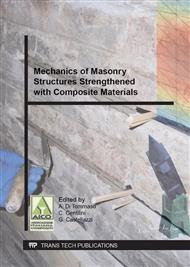p.66
p.74
p.80
p.88
p.97
p.106
p.114
p.123
p.131
An Analytical Mechanical Model for the Seismic Assessment of Bell Towers
Abstract:
The paper describes the analytical model, recently proposed in the Perpetuate Project, aimed to assess the seismic response of the shaft of bell towers, of which the vulnerability to the seismic action has been dramatically testified also by the recent events (as that which hit L’Emilia region in 2012). As main novelties, the model follows the Displacement Based Approach (DBA) for the seismic verification and catches both the shear and combined bending and compression response of the main body of bell towers. In order to clarify the application and to provide a preliminary validation of the proposed model, the seismic response of the bell tower of the San Carlo Church in Castellazzo Bormida (Al, Italy) has been studied. It includes also a detailed analysis on a 3D FEM model aimed to support the calibration of some parameters which the model is founded on in case of quite irregular bell towers characterized by non symmetric boundary conditions that can significantly affect their dynamic behavior, as the case analyzed.
Info:
Periodical:
Pages:
97-105
Citation:
Online since:
September 2014
Authors:
Price:
Сopyright:
© 2015 Trans Tech Publications Ltd. All Rights Reserved
Share:
Citation:


